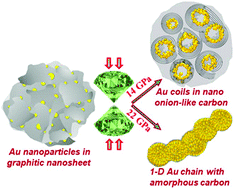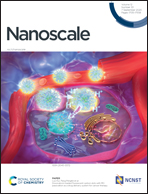Pressure-induced assemblies and structures of graphitic-carbon sheet encapsulated Au nanoparticles†
Abstract
A novel strategy of using hydrostatic pressures to synthesize gold–carbon (Au–C) nanohybrid materials is explored. The stable face-centered-cubic (fcc) Au undergoes a structural phase transition to a mixture of primitive orthorhombic and cubic phases as the carbon phase acquires a highly ordered onion-like carbon (OLC) structure which encapsulates the Au nanoparticles, thereby exerting an additional pressure. Increasing the pressure results in a one dimensional (1-D) chain-like structure with the primitive cubic Au nanoparticles contained in an amorphous carbon matrix. The OLC structure allows the formation of quenchable Au nanoparticle phases with the primitive close packing and Au–C hybrids with new mesoscopic structures. Under pressure, we observe the formation of a hybrid material composed of a poorly conducting matrix made of amorphous carbon and conducting OLC-encapsulated Au nanoparticles. The electrical conductivity of this hybrid material under pressure reveals a percolation threshold. We present a new synthesis approach to explore the interplay between atomic and mesoscopic structures and the electrical conductivity of metal hybrid structures.



 Please wait while we load your content...
Please wait while we load your content...